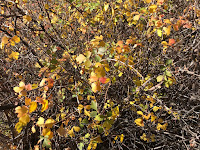Yvette Henson, CSU Extension, San Miguel Basin
We all love the golds and oranges of our native aspen and cottonwood trees and we take annual drives into the mountains in late September and October to see them in their glory. But, we don’t give as much attention to other native shrubs that also have good fall color.
In Colorado, western Colorado at least, our scrub oaks (Quercus
gambelii) are a major contributor to our fall color and the hillsides look
like Oriental carpets of burnt ochre, sienna, rust and chartreuse. Some other native shrubs that add to the
color palette are the burgundy leaves and stems of red twig dogwoods and gilded
willows growing along riverbanks, the rusty reds and oranges of three leaved
sumacs and wild roses on the hillsides and roadsides.
Red-twig dogwoods, Cornus sericea, is popular in the landscape
industry because of its colorful red or yellow branches make a show in the
winter, especially against the snow. Burgundy
fall color is a beautiful contrast under native cottonwoods, along rivers. In this photo, native virgin’s bower, Clematis
ligusticifolia, is growing over it.
Three-leaved sumac, Rhus trilobata, is also a
favorite fall shrub for its varied rusty-red to chartreuse colored
foliage. In the early summer it produces
salty-sour fruit that is good for making a lemonade like beverage. In extreme western Colorado, there is a
variety with simple, rather than compound leaves.
Wild roses (Rosa spp.) have similar fall color to three-leaved
sumacs and also have colorful red hips that are high in vitamin C and are great
for tea and homemade beauty products.
There are more native shrubs that add to our colorful fall, such as barberries (Berberis spp.), currants (Ribes spp.), sometimes snowberries (Symphoriocarpus spp.) and serviceberries (Amelanchier spp.). Comment on others.







Great article, love the pictures!
ReplyDeleteI was also pleasantly surprised by my 2 year old western sand cherries (prunus besseyi). They have turned a medium reddish color. Thanks for the good info!
ReplyDeleteThank you for the photos and info!
ReplyDelete